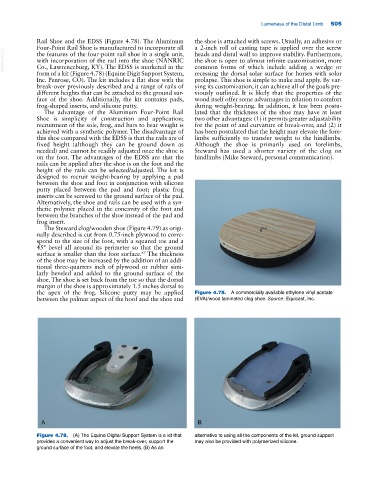Page 539 - Adams and Stashak's Lameness in Horses, 7th Edition
P. 539
Lameness of the Distal Limb 505
Rail Shoe and the EDSS (Figure 4.78). The Aluminum the shoe is attached with screws. Usually, an adhesive or
Four‐Point Rail Shoe is manufactured to incorporate all a 2‐inch roll of casting tape is applied over the screw
VetBooks.ir with incorporation of the rail into the shoe (NANRIC the shoe is open to almost infinite customization, more
heads and distal wall to improve stability. Furthermore,
the features of the four‐point rail shoe in a single unit,
common forms of which include adding a wedge or
Co., Lawrenceburg, KY). The EDSS is marketed in the
form of a kit (Figure 4.78) (Equine Digit Support System, recessing the dorsal solar surface for horses with solar
Inc. Penrose, CO). The kit includes a flat shoe with the prolapse. This shoe is simple to make and apply. By var-
break‐over previously described and a range of rails of ying its customization, it can achieve all of the goals pre-
different heights that can be attached to the ground sur- viously outlined. It is likely that the properties of the
face of the shoe. Additionally, the kit contains pads, wood itself offer some advantages in relation to comfort
frog‐shaped inserts, and silicone putty. during weight‐bearing. In addition, it has been postu-
The advantage of the Aluminum Four‐Point Rail lated that the thickness of the shoe may have at least
Shoe is simplicity of construction and application; two other advantages: (1) it permits greater adjustability
recruitment of the sole, frog, and bars to bear weight is for the point of and curvature of break‐over, and (2) it
achieved with a synthetic polymer. The disadvantage of has been postulated that the height may elevate the fore-
this shoe compared with the EDSS is that the rails are of limbs sufficiently to transfer weight to the hindlimbs.
fixed height (although they can be ground down as Although the shoe is primarily used on forelimbs,
needed) and cannot be readily adjusted once the shoe is Steward has used a shorter variety of the clog on
on the foot. The advantages of the EDSS are that the hindlimbs (Mike Steward, personal communication).
rails can be applied after the shoe is on the foot and the
height of the rails can be selected/adjusted. The kit is
designed to recruit weight‐bearing by applying a pad
between the shoe and foot in conjunction with silicone
putty placed between the pad and foot; plastic frog
inserts can be screwed to the ground surface of the pad.
Alternatively, the shoe and rails can be used with a syn-
thetic polymer placed in the concavity of the foot and
between the branches of the shoe instead of the pad and
frog insert.
The Steward clog/wooden shoe (Figure 4.79) as origi-
nally described is cut from 0.75‐inch plywood to corre-
spond to the size of the foot, with a squared toe and a
45° bevel all around its perimeter so that the ground
67
surface is smaller than the foot surface. The thickness
of the shoe may be increased by the addition of an addi-
tional three‐quarters inch of plywood or rubber simi-
larly beveled and added to the ground surface of the
shoe. The shoe is set back from the toe so that the dorsal
margin of the shoe is approximately 1.5 inches dorsal to
the apex of the frog. Silicone putty may be applied Figure 4.79. A commercially available ethylene vinyl acetate
between the palmar aspect of the hoof and the shoe and (EVA)/wood laminated clog shoe. Source: Equicast, Inc.
A B
Figure 4.78. (A) The Equine Digital Support System is a kit that alternative to using all the components of the kit, ground support
provides a convenient way to adjust the break‐over, support the may also be provided with polymerized silicone.
ground surface of the foot, and elevate the heels. (B) As an

